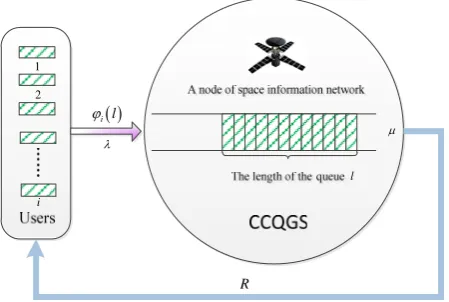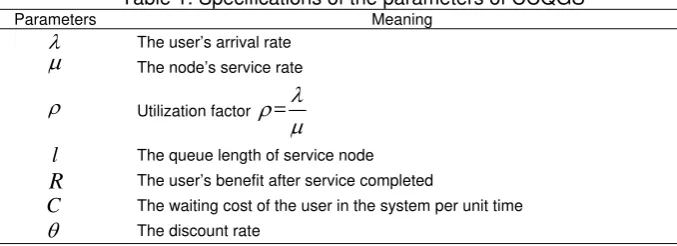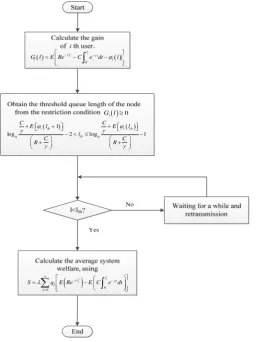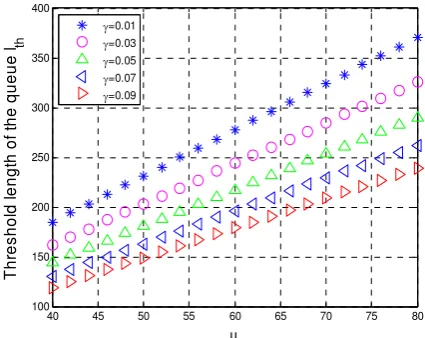DOI: 10.12928/TELKOMNIKA.v13i3.1799 844
A Congestion Control Algorithm Based on Queuing
Game for Space Information Network
Chao Guo*, Haitao Xu, Guocai Jia, Zhiyong Yao
School of Computer and Communication Engineering, University of Science and Technology Beijing, Beijing, 100083, P. R. China
*Corresponding author, e-mail: [email protected]
Abstract
In space information network, the long delay and high link error rate are the most different characteristics from the traditional ground network. Based on the queuing game theory, a novel congestion control is proposed in this paper. It assumes that the users pay an admission fee for entering the queue, and then cost during the waiting time, at last they obtain a benefit from the node when they are serviced completely. This paper not only designs a variable admission fee in order that the proposed algorithm is more suitable for the space environment, but also considers the ending profits of the game which is described by a discount rate. The simulation result shows the proposed algorithm improve the network performance.
Keywords: congestion control; queuing game; space information network; ending profit
Copyright © 2015 Universitas Ahmad Dahlan. All rights reserved.
1. Introduction
The space information network is developed and formed on the basis of the ground network. It consists of the deep space network, the satellite network, the aviation network and the traditional ground network [1]. Under the current situation that each country begins to snatch the limited communications resources over space, how to utilize space information network resources efficiently has become a focus [2]. Therefore, whether a congestion control scheme is good or not is extremely important. However, due to the long delay and the high link error rate of the high layer network including the deep space network and the satellite network [3], the traditional congestion control method of the ground network is unsuitable for the whole space information network.
In order to solve the congestion problem in the satellite network, there were some researchers who proposed reasonable resource allocation schemes as in [4]. The authors adjusted the traffic speed by changing the congestion window size of the node in the network. These schemes were all based on the feedback information of the nodes [5, 6]. Although these schemes were able to reflect the current network state, the too long delay caused by the propagation of the inquiry and feedback information led the network resources waste. Considering the global situation of the network, authors in [7] built a bargaining model based on game theory. They observed and analyzed the characteristic of the network resource from the perspective of game theory, which offered a new idea for dealing with the network congestion. What’s more, authors in [8] formulated a complex mathematical model based on the stochastic differential game theory. It described dynamic changes of network resources at any time, and obtained an optimal strategy for resource allocation through solving the feedback Nash equilibrium of the model. It was built according to the real network environment and could be solving, but some other models which were built in the same way might not exist the corresponding feedback Nash equilibrium solution.
application of CCQGS makes the network social profit reaches the maximum. Then we get the optimal queue length to achieve the congestion control in space information network.
The rest of this paper is organized as follows. In section 2, the system model is described. The design of congestion control algorithm under the queuing game model is given in Section 3. The simulation and comparisons are done in Section 5. At last, we drew a conclusion in Section 6.
2. System Model
CCQGS is designed to balance the space information network load and reduce the congestion. It determines the rules for users to enter the queues of the system nodes. Since a newly arrived user needs to wait for the service if there are other users in front of him, this waiting time causes an extra income when the service ends. We describe it as a discount rate [10] in the following system model.
i l
l
1
2
R i
Figure 1. The system model of congestion control for space information network
In our proposed model as shown in Figure 1, a user i i
N
who wants to enter the space information network will obtain the user’s benefitR
from the system if the service is completed. However, the useri
needs to pay an admission fee
i before joining the queue of the service node. Users arrive as Poisson distribution with the arrival rate and the network nodes service time follow exponential distribution with the service rate
[11]. When a user enters the queue and before being serviced, he must wait for a period of time which forms the waiting cost per unit time C. The current number of users in the queue called the queue length are denoted as l.The gain G li
of useri
is the criteria for deciding whether to join the queue or not. It is computed by the user’s benefit subtracting the admission fee and the waiting cost. If
0i
G l , the user will join the queue. On the contrary, if G li
0, the user will balk because there is no gains even losses for him. Notice that the service node announces the gain G li
to the useri
, it utilizes the user’s benefitR
which should be obtained after service completed. Therefore, a discount rate is introduced in our proposed system model.Table 1. Specifications of the parameters of CCQGS
Parameters Meaning
The user’s arrival rate
The node’s service rate Utilization factor
=
l The queue length of service node
R
The user’s benefit after service completedC The waiting cost of the user in the system per unit time
The discount rate
3. A Congestion Control Algorithm Based on Queuing Game
The system welfare consists of the user’s gain and the node’s profit mainly from the admission fee. Due to the determined user’s benefit and the increasing admission fee with the increasing queue length, the user’s gain and the node’s profit are conflicting. When the queue length grows, the user’s gain decreases. Once it is less than zero, the user balks the queue. Meanwhile, the node’s profit increases. We assumes that a user joins the queue at time 0 and complete the service at time t1. In our system model, the system welfare of user
i
can beAfter getting the each user’s system welfare, the average system welfare contribution can be computed as:
Whereql denotes the probability of observing l users in the queue.
According to the restriction condition G li
0, CCQGS judges a user can join the queue only if he satisfies this condition. Our congestion control algorithm is an initiative scheme, so that users are able to choice the favorable behavior. We turn this restriction to a threshold queue length of node. It is easy for user’s discrimination. The user’s gainG li
can be calculated as:Because that the service time of the node in space information network follows the exponential distribution with a parameter . When a new user arrives to the node and observes
that there have been l users already in the queue, the service completed time t1 follows the Erlang distribution with parameters and l1. According to these assumption we obtains the formulation as:
1 1 it l
Where
.
Computing the expression in (3), we can obtains:
l 1
When the user’s gain satisfies G li
0, the restrictionexpression can be rewrite as follow: length is the threshold denoted as lth. The conditions are given as:
Solving the above the inequality equations, the threshold queue lengthlth is calculated as:
The user firstly comes to the space information network, and then the service node announces an admission fee to the user with the consideration of the current number of users in the queue. The user calculates his gain according to the received admission fee and the waiting cost. If the user’s gain is no less than zero, he joins the queue. Otherwise he balks. During the discussion of the user’s gain, a threshold queue length is deducted for the congestion control scheme for space information network. The flow chart of CCQGS is draw as Figure 2.
1
Figure 2. The flow chart of CCQGS
4. Simulation and Comparisons
In this section, we give some simulations and analysis to prove the correctness and the effectiveness of CCQGS. Firstly, the influence of the discount rate to the threshold queue length lth is experimented. Under the restriction condition of lth, Matlab is used to calculate the interrelated parameters and show the numerical result. It is helpful for us to realize the extra benefit of system from ending profit of the game. Then we observe the relationship between the queue length and the arrival rate. Users in space information network come with different probabilities, for understanding the impact to the system, we do the second experiment. Since our algorithm is based on queuing game theory which is rarely used in congestion control, it is hard to compare with other similar algorithm. We just do some numerical simulation to analysis and compare the results with different parameters.
On basis of the queuing game theory, we built the system model and simulate the network environment. The simulation parameters are shown in Table 2.
Table 2. The value of the simulation parameters
R C
40 60 100 10
In this simulation, we define the admission fee
l l to shown the changes of thesystem. The discount rate is assumed as
0.01, 0.02, 0.03, 0.04, 0.05, 0.06, 0.07, 0.08, 0.08, 0.1
.decreases. The reason is that express the ending profits. The more is, the smaller the user’s gain becomes. Once the user’s gain drops, the new arrival user will balk the queue with the restriction G li
0. Due to lthN, we round the value in the simulation and get the threshold queue length.Figure 3. Threshold queue length for different
As shown in Figure 4, we can observe the threshold queue length lth grows with the increase of the service rate . When the service rates are the same, the threshold queue length is lower with the larger discount rate. It means that after users join in the queue of the node in space information network, if the node services the more users per unit time, the more network traffic can be processed in our proposed model.The threshold queue length denotes the capacity of node. The higher it is, the more information can be handled in the system. According to the queuing game model, we can get the optimal system welfare and avoid the network congestion.
Figure 4. Threshold queue length for different
5. Conclusion
Considering the special space information network environment, we design a congestion control algorithm CCQGS to achieve the reasonable distribution of network resources. On the basis of the queuing theory and the game theory, a system model is formulated to reduce the probability of the congestion occurring. We define a variable admission fee instead of a constant one so that the model can describe the network system more real. Besides, a discount rate is introduced to the proposed model to present the ending profit of the game. At last, better performance of the network is obtained in the simulations.
In the future work, we will do some reseaches on the performance comparision between our algorithm and others and solve the routing problem in space information network.
Acknowledgements
We gratefully acknowledge anonymous reviewers who read drafts and made many helpful suggestions. This work is supported by the National Science Foundation Project of P. R. China (61272507), China Postdoctoral Science Foundation (2013M530526), the Fundamental Research Funds for the Central Universities (FRF-TP-09-015A).
References
[1] Fiaschetti A, Fiaschetti M, Pietrabissa A, Petrone M. Congestion pricing for dynamic bandwidth allocation in satellite networks: A game-theoretic approach. Satellite Telecommunications (ESTEL), 2012 IEEE First AESS European Conference. 2012: 1-6.
[2] Hongying L, Zhiming Y, Zhigang C. Max-Min Rate Control on Traffic in Broadband Multibeam Satellite Communications Systems. Communications Letters, IEEE. 2013; 17(7): 1396-1399.
[3] Gangadhar S, Nguyen TAN, Umapathi G, Sterbenz JPG. TCP Westwood(+) protocol implementation in ns-3. Proceedings of the 6th International ICST Conference on Simulation Tools and Techniques. Cannes, France: ICST (Institute for Computer Sciences, Social-Informatics and Telecommunications Engineering). 2013: 167-175.
[4] Taleb T, Kato N, Nemoto Y. REFWA: An Efficient and Fair Congestion Control Scheme for LEO Satellite Networks. Networking, IEEE/ACM Transactions. 2006; 14(5): 1031-1044.
[5] Torres R, Border J, Choquette G, Jun X, Je-Hong J. Congestion control using RED and TCP window adjustment. MILITARY COMMUNICATIONS CONFERENCE, 2012 - MILCOM 2012. 2012.
[6] Utsumi S, Salim Zabir SM, Shiratori N. TCP-Cherry: A new approach for TCP congestion control over satellite IP networks. Computer Communications. 2008; 31(10): 2541-2561.
[7] Petraki DK, Anastasopoulos MP, Hsiao-Hwa C, Cottis PG. Distributed Resource Allocation for Delay-Sensitive Services in Satellite Networks Using Game Theory. Computational Intelligence and AI in Games, IEEE Transactions. 2009; 1(2): 134-144.
[8] Long Z, Xianwei Z. Joint cross-layer optimised routing and dynamic power allocation in deep space information networks under predictable contacts. Communications, IET. 2013; 7(5): 417-429.
[9] Naor P. The Regulation of Queue Size by Levying Tolls. Econometric. 1969; 37(1): 15-24.
[10] Chen H, Frank M. State Dependent Pricing with a Queue. IIE Transactions. 2001; 33(10): 847-860. [11] Yi G, Hua L, Krishnamachari B. A packet dropping-based incentive mechanism for M/M/1 queues with



